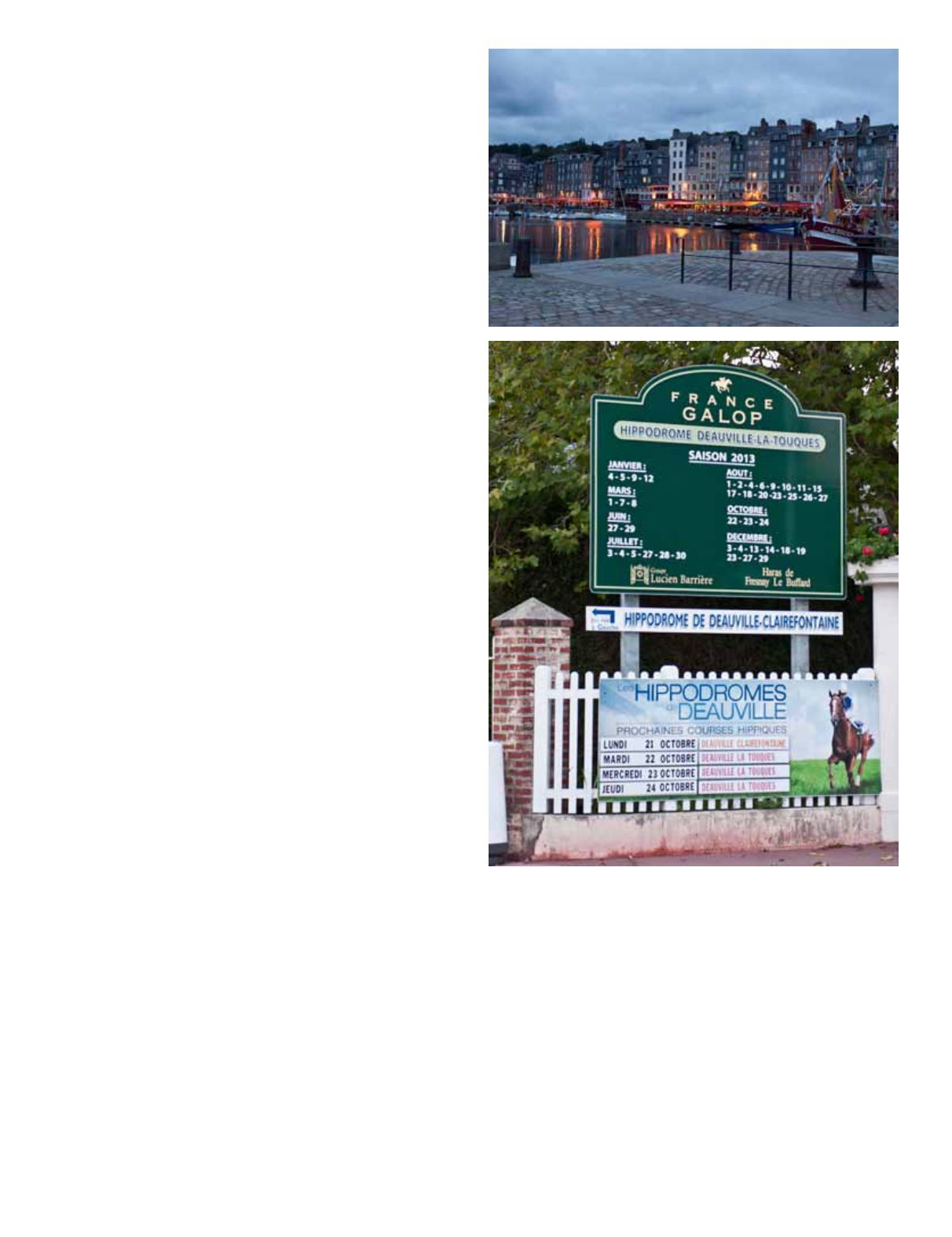
160 SIDELINES MARCH 2014
FOR HORSE PEOPLE • ABOUT HORSE PEOPLE
FOR HORS PEOPLE • ABOUT HORSE PEOPLE
SIDELINES JUNE 2012 3
was as good as the guidebooks proclaimed.
Back in Trouville at our hotel, I said good night to my travel
companions and tried to get some sleep. Our next day started
early as we were scheduled to visit a calvados distillery in the
Pays d’ Auge (an area famous for its apples and dairy products),
the city of Caen and the Normandy Beaches.
Day 2 – Calvados, Caen and the D-Day Beaches
I met everyone in the breakfast room at the hotel with luggage
in hand ready to be loaded onto our bus. A typical breakfast
offered at many of the hotels during my stay in France consisted
of: coffee, tea, juices, fruit (usually including kiwis, oranges,
apples and sometimes applesauce), yogurt, pastries, butter and
jam, cold meats and cheeses, cereal and milk, soft boiled eggs
and occasionally crepes.
As we started our route to the distillery the bus took us
past the racetrack (Hippodrome de Deauville) in neighboring
Deauville. Since it will be the location of the polo venue during
the Games, we convinced our guide to stop so that we could
walk around and take photos for a few minutes. The exercise
jockeys were just finishing up with a group of racehorses and we
watched them parade back to the stables; they waved at us as
we took their photos.
Back on the bus we traveled to the Boulard Calvados
Distillery in the village of Pont l’Evêque (
.
com). There, we were greeted by two distillery representatives
who explained that in order for the apple-based liquor to be
called calvados, it must be produced in that region of France.
Calvados is a mix of four different kinds of cider apples to give
it the special full bouquet: sweet, bittersweet, bitter apples and
slightly acidic (there is also one area where they use pears
in the mix as well, but not at Boulard). They start the process
with freshly pressed apple cider, which goes through a double
distillation, is aged in oak casks and eventually they end up with
calvados. The finished product is a blend of several different
ages of calvados in secret proportions (as determined by the
cellar master). After a visit to the tasting room at Boulard where
we sampled several of their labels, we headed off on our bus to
the city of Caen.
I was excited as we drove to Caen as I wanted to see the
venues for the Alltech FEI World Equestrian Games 2014 as
well as visit one of the hotels that will house the media during
the Games. First, we stopped at the Caen headquarters for
Alltech, the title sponsor of the Games, where we were treated
to a catered lunch and met representatives of Alltech and from
the Organizing Committee of the Normandy Games. Then, our
bus route took us past: the Prairie Racecourse (Hippodrome)
where driving and para-dressage will be held; the Zenith Indoor
Arena where vaulting will be staged; the Exhibition Centre
where reining will be contested; and the D’Ornano Stadium
where dressage, show jumping and the stadium jumping for the
eventers will take place.
Although we did not get a chance to visit it on our tour,
Caen has an extensive World War II museum called the Caen
Memorial Museum that is well worth mentioning. The town hall
built in 1060 by William the Conqueror is a beautiful sprawling
chateau that deserves a look as well.
After our quick driving tour of Caen, we headed northwest
to the D-Day beaches. When we arrived there we were met by
three men from the D-Day Academy (
) who were
our tour guides, one Brit and two Frenchmen. The academy
guides provided us not only with a well-versed history of the
World War II battle, but also with rides in three vintage WWII
vehicles: a GMC “deuce and a half” cargo truck; a Willis Jeep;
and a Dodge command vehicle. Our docent said that if you want
to try to understand what it was like on D-Day he recommended
the film
The Longest Day
or the opening scene of
Saving Private
Ryan.
We visited Omaha Beach where the Americans came ashore
and Pointe du Hoc where a company of U.S. Army Rangers
scaled a steep cliff to take over German gun turrets. Then,
we drove to the family-owned Chateau Bouché that had been
the site of the first American graves as a result of the Battle of
Normandy – a memorial to those fallen soldiers still exists in
the yard of the chateau. Tours with the D-Day Academy start at
65 Euros according to their brochure and it was well worth the
time and money. I was ready to feel somber while visiting the
area, but it was even more emotional than I had anticipated. To
actually see the terrain that faced the soldiers on D-Day really
gave you an appreciation for their almost unbelievable sacrifice.
By evening we were settled into the gorgeous Chateau de
Sully (
) near the town of Bayeux.
The Chateau was built around 1720 and was occupied by
Vieux Bassin in Honfleur
Hippodrome de Deauville
Continued on page 162


